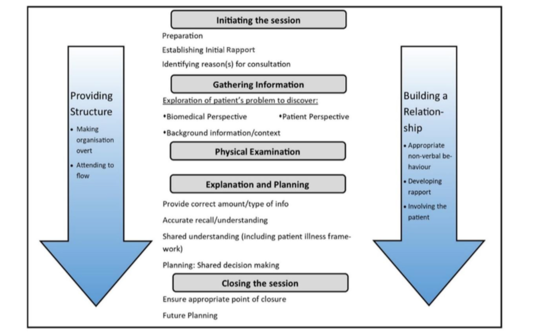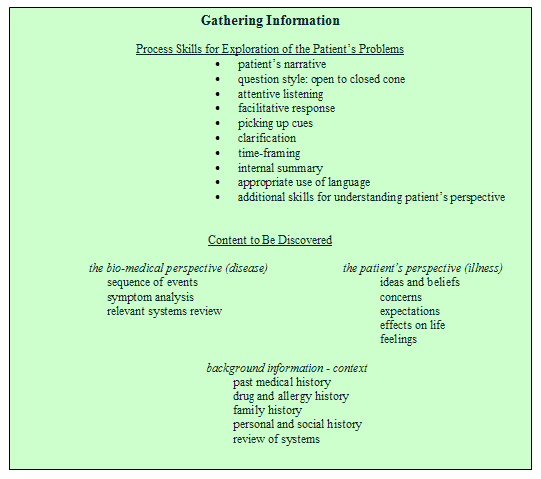Calgary-Cambridge Guide to the Medical Interview - Closing the Session: Difference between revisions
Carin Hunter (talk | contribs) No edit summary |
Carin Hunter (talk | contribs) No edit summary |
||
| Line 1: | Line 1: | ||
== Introduction == | == Introduction == | ||
The importance of communication in obtaining good health outcomes is well-known.<ref>Hiller A, Delany C. [https://www.semanticscholar.org/paper/Communication-in-physiotherapy%3A-challenging-Hiller/6f7bf1de5ae21579737e0a7aeb9744981af29497 Communication in physiotherapy: Challenging established theoretical approaches. Manipulating Practices:] A Critical Physiotherapy Reader. 2018:308-33.</ref> Communication is a teachable skill which is incorporated in the training of medical professionals at tertiary institutions worldwide. The teaching of communication skills is often based on models of communication, the products of extensive research, providing frameworks for gaining clinical data, building rapport and deciding on clinical management<ref>Modi, J.N., Anshu, Chhatwal, J., Gupta, P., Singh, T., [https://pubmed.ncbi.nlm.nih.gov/27376604/ Teaching and assessing communication skills in medical undergraduate training]. Indian Pediatr. 2016 53, 497–504</ref> . Kurtz and Silverman<ref>Kurtz, S.M., Silverman, J.D.. [https://psycnet.apa.org/record/1996-04140-001 The Calgary-Cambridge Referenced Observation Guides: an aid to defining the curriculum and organizing the teaching in communication training programmes]. Med. Educ. 1996 30, 83–89.</ref> introduced the Calgary-Cambridge Referenced Observation Guides, which they further refined in the early 2000s. These guidelines, which presents the medical interview in five steps, are the result of the collaboration between two very experienced teachers in clinical communication. The guide was originally intended for use in clinical education at tertiary institutes. The model has since been adapted and used in various health disciplines and serves as a blueprint for many educational institutions in the teaching of education to aspirant health care professionals<ref name=":0">Kurtz, S., Silverman, J., Benson, J., Draper, J. [https://pubmed.ncbi.nlm.nih.gov/12915371/ Marrying Content and Process in Clinical Method Teaching: Enhancing the Calgary–Cambridge Guides.] Acad. Med. 2003 78, 802–809.</ref>. | The importance of communication in obtaining good health outcomes is well-known.<ref>Hiller A, Delany C. [https://www.semanticscholar.org/paper/Communication-in-physiotherapy%3A-challenging-Hiller/6f7bf1de5ae21579737e0a7aeb9744981af29497 Communication in physiotherapy: Challenging established theoretical approaches. Manipulating Practices:] A Critical Physiotherapy Reader. 2018:308-33.</ref> Communication is a teachable skill which is incorporated in the training of medical professionals at tertiary institutions worldwide. The teaching of communication skills is often based on models of communication, the products of extensive research, providing frameworks for gaining clinical data, building rapport and deciding on clinical management<ref>Modi, J.N., Anshu, Chhatwal, J., Gupta, P., Singh, T., [https://pubmed.ncbi.nlm.nih.gov/27376604/ Teaching and assessing communication skills in medical undergraduate training]. Indian Pediatr. 2016 53, 497–504</ref> . Kurtz and Silverman<ref>Kurtz, S.M., Silverman, J.D.. [https://psycnet.apa.org/record/1996-04140-001 The Calgary-Cambridge Referenced Observation Guides: an aid to defining the curriculum and organizing the teaching in communication training programmes]. Med. Educ. 1996 30, 83–89.</ref> introduced the Calgary-Cambridge Referenced Observation Guides, which they further refined in the early 2000s. These guidelines, which presents the medical interview in five steps, are the result of the collaboration between two very experienced teachers in clinical communication. The guide was originally intended for use in clinical education at tertiary institutes. The model has since been adapted and used in various health disciplines and serves as a blueprint for many educational institutions in the teaching of education to aspirant health care professionals<ref name=":0">Kurtz, S., Silverman, J., Benson, J., Draper, J. [https://pubmed.ncbi.nlm.nih.gov/12915371/ Marrying Content and Process in Clinical Method Teaching: Enhancing the Calgary–Cambridge Guides.] Acad. Med. 2003 78, 802–809.</ref>. | ||
[[File:Calgary Cambridge Model.png|thumb|541x541px|Figure 1: Layout of the Calgary Cambridge Model]] | |||
Challenges experienced in the learning of communication include the integration of communication skills with other clinical skills, and the effective carryover of theoretically taught communication skills into real-life scenarios. According to Kurtz et al<ref name=":0" />, these hardships are experienced because students struggle to combine the focus on interview ''content'' (i.e. information gained) with the ''process'' of communication during the interview (for example, non-verbal behaviour). The Calgary-Cambridge model teaches communication focusing on both interview content and process simultaneously, thereby integrating the traditional clinical method of history taking with effective communication skills. Patient-centred medicine has been incorporated in both content and process<ref name=":0" />. | Challenges experienced in the learning of communication include the integration of communication skills with other clinical skills, and the effective carryover of theoretically taught communication skills into real-life scenarios. According to Kurtz et al<ref name=":0" />, these hardships are experienced because students struggle to combine the focus on interview ''content'' (i.e. information gained) with the ''process'' of communication during the interview (for example, non-verbal behaviour). The Calgary-Cambridge model teaches communication focusing on both interview content and process simultaneously, thereby integrating the traditional clinical method of history taking with effective communication skills. Patient-centred medicine has been incorporated in both content and process<ref name=":0" />. | ||
[[File:Layout of the Calgary-Cambridge Model- Detailed, with objectives.png|thumb|541x541px|Figure 2: Layout of the Calgary Cambridge Model, with objectives]] | [[File:Layout of the Calgary-Cambridge Model- Detailed, with objectives.png|thumb|541x541px|Figure 2: Layout of the Calgary Cambridge Model, with objectives]] | ||
Revision as of 09:27, 25 March 2021
Introduction[edit | edit source]
The importance of communication in obtaining good health outcomes is well-known.[1] Communication is a teachable skill which is incorporated in the training of medical professionals at tertiary institutions worldwide. The teaching of communication skills is often based on models of communication, the products of extensive research, providing frameworks for gaining clinical data, building rapport and deciding on clinical management[2] . Kurtz and Silverman[3] introduced the Calgary-Cambridge Referenced Observation Guides, which they further refined in the early 2000s. These guidelines, which presents the medical interview in five steps, are the result of the collaboration between two very experienced teachers in clinical communication. The guide was originally intended for use in clinical education at tertiary institutes. The model has since been adapted and used in various health disciplines and serves as a blueprint for many educational institutions in the teaching of education to aspirant health care professionals[4].
Challenges experienced in the learning of communication include the integration of communication skills with other clinical skills, and the effective carryover of theoretically taught communication skills into real-life scenarios. According to Kurtz et al[4], these hardships are experienced because students struggle to combine the focus on interview content (i.e. information gained) with the process of communication during the interview (for example, non-verbal behaviour). The Calgary-Cambridge model teaches communication focusing on both interview content and process simultaneously, thereby integrating the traditional clinical method of history taking with effective communication skills. Patient-centred medicine has been incorporated in both content and process[4].
The Calgary-Cambridge model is presented in three diagrams, which aids to enhance communication skills training visually and conceptually. The first diagram (Figure 1) summarises the medical interview as a sequential five-step process: initiation of the session; gathering information; physical examination; explanation and planning; and closing the session.
In the traditional medical assessment, the subjective and objective examinations were considered two different entities. In the Calgary-Cambridge guide, they are integrated, with the inclusion of “physical examination” into the model. Hereby, the interdependence of information gathering from the physical assessment and verbal communication in the natural flow of a true-life medical assessment is illustrated. Provision of structure and relationship building are two steps that continue throughout the entire interview and that develops increasingly as the interview progresses. Figure 2 provides more detail and achievable, evidence-based objectives in each of the steps in the medical interview. The last diagram (Figure 3) shows the interrelationship between content and process, using the example of the gathering of information[4].
Figure 3: Relationship between content and process
The Calgary-Cambridge model provides a practical, integrated method of teaching both the process of communication, as well as the effective gaining of content information[5]. It incorporates the importance of patient-centred medicine including the building of a relationship and shared decision making[6]. The model has been the base of many medical interviews and continues to provide guidance to clinicians in all fields of medicine.
Watch this video if you want to learn more about the Calgary Cambridge Guide to the Medical Interview:
- ↑ Hiller A, Delany C. Communication in physiotherapy: Challenging established theoretical approaches. Manipulating Practices: A Critical Physiotherapy Reader. 2018:308-33.
- ↑ Modi, J.N., Anshu, Chhatwal, J., Gupta, P., Singh, T., Teaching and assessing communication skills in medical undergraduate training. Indian Pediatr. 2016 53, 497–504
- ↑ Kurtz, S.M., Silverman, J.D.. The Calgary-Cambridge Referenced Observation Guides: an aid to defining the curriculum and organizing the teaching in communication training programmes. Med. Educ. 1996 30, 83–89.
- ↑ 4.0 4.1 4.2 4.3 Kurtz, S., Silverman, J., Benson, J., Draper, J. Marrying Content and Process in Clinical Method Teaching: Enhancing the Calgary–Cambridge Guides. Acad. Med. 2003 78, 802–809.
- ↑ Ammentorp J, Bigi S, Silverman J, Sator M, Gillen P, Ryan W, Rosenbaum M, Chiswell M, Doherty E, Martin P. Upscaling communication skills training–lessons learned from international initiatives. Patient Education and Counseling. 2020 Aug 28.
- ↑ Main, C.J., Buchbinder, R., Porcheret, M., Foster, N. Addressing patient beliefs and expectations in the consultation. Best Pract. Res. Clin. Rheumatol. 2010 24, 219–225.
- ↑ Dr Alex. 2018. Introduction to the Calgary Cambridge Guide to the Medical Interview. Available from: https://www.youtube.com/watch?v=zjAqbWvnFB0









